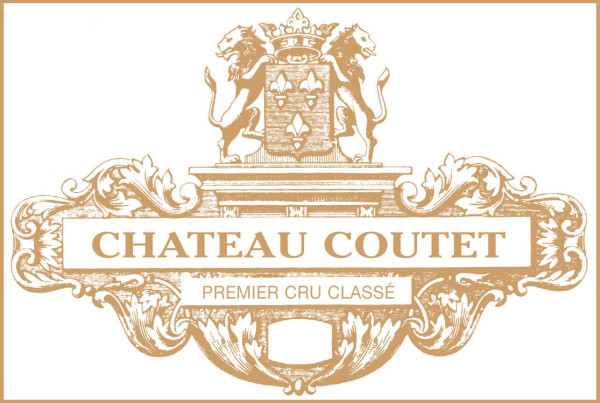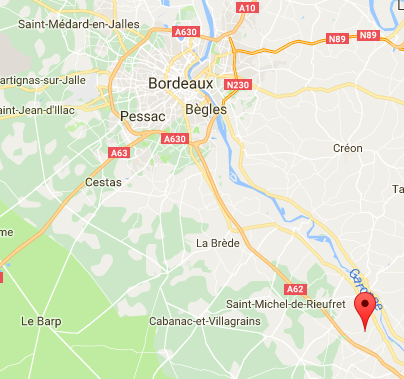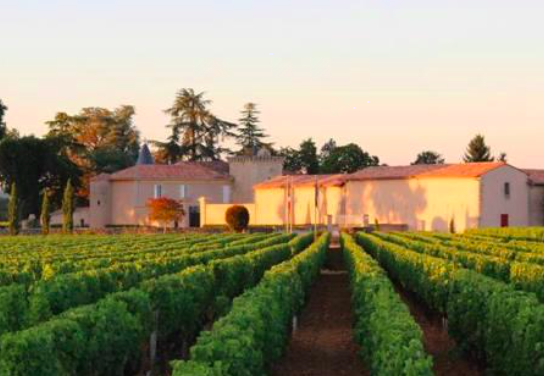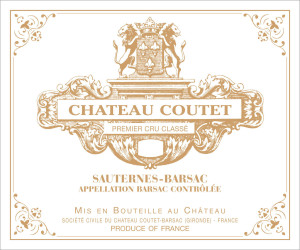

The Estate
Château Coutet is a large vineyard, the largest in Barsac in fact; the entire estate amounts to 42 hectares, of which 38.5 hectares are committed to the vine. The estate is bisected only by a narrow road which runs up through Coutet. The estate lies 12 meters above sea level, an almost mountainous altitude for this region.
Château Coutet vines’ deep roots extract elements from its terroir to give the grapes freshness, richness, and strength. For this reason the estate carries the name “Coutet,” derived from the Gascon’s word for knife, to signify the fresh, lively and crisp palate that is the wine’s signature style.
The Vines
The vines are 75% Semillon and 23% Sauvignon Blanc, and 2% Muscadelle. There is an ongoing program of replanting in order to replace older stock and keep the average age of the vines at about 35 years old. They are planted on the usual Bordeaux rootstocks, Riparia-Gloire and 420A, with a density of 7,500 vines per hectare.

The Soil
As is typical of the Barsac vineyards, the soils underfoot are a mix of gravel and the classic red clay of the appellation over a limestone bedrock rich in starfish and shellfish fossils. The yields are typically 9 hl/ha, a remarkably low figure due to the botrytis-induced dehydration of the fruit, with the number of tries reaching double figures in some vintages, although the average number is six.
Vinification
The fruit is crushed using a traditional vertical press alongside a more modern cylindrical machine. The fruit is then transferred to 100% new barrels for fermentation. The blending will typically yield a wine that is richer in Semillon than the vineyard might suggest, with this variety typically accounting for 84% of the assemblage, with the rest being 14% Sauvignon Blanc and 2% Muscadelle. For some vintages, the amount of Semillon may be higher, up to 90%. The élevage will last for up to 18 months before bottling.
Wines and Production
The grand vin is Château Coutet, which has an annual production of up to 3,500 cases. The second wine, Chartreuse de Coutet, was first introduced in 1977 and has an annual production of about 400 cases. There is also a dry Graves, the Vin Sec de Château Coutet. The crème de la crème, however, is a super-selection named Cuvée Madame, only released in vintages of exceptional quality.

Château Coutet Sauternes-Barsac 1er Cru Classé
Production Area: 38.5 ha (95 acres)
Grape Varietals: Sémillon, Sauvignon Blanc, Muscadelle
Soil: Clay with a limestone sub-soil
Average Age of the Vines: 38 years old
Plantation Density: 7,500 plants/ha (3,000 plants/acre)
Vineyard Management: “Taille à Cot” (traditional Sauternes pruning), rational cultivation
Harvest: Manual with several tries
Average Yield: 9 hl/ha (0.9 ton per acre)
Aging: 18 months in French oak barrels (70-100% new wood)
Winemaker Notes: “In its youth, the wines display generous notes of white flowers, citrus fruits, honey and vanilla. Ginger and pineapple are very typical aromas in a young Château Coutet. Time brings out deeper, warmer notes in which spices combine with exotic nectars and candied fruits, such as gingerbread mingled with marmalade. Age also enhances the harmony of its roasted Botrytis character and its distinct aromas to give Château Coutet a delicate and unique bouquet that is unsurpassed.”
2017 Reviews: “This wine shows great balance and poised elegance. Its botrytis fruit gives it rich intensity, with a ripe orange-marmalade flavor and layers of tight acidity. This will be a wine for serious aging and not ready to drink before 2024.” – 96pts, Wine Enthusiast
2016 Reviews: “This wine is dense, mingling spicy nutmeg along with superb ripe honey and marmalade flavors. With its balanced acidity and opulence, it is going to be a great wine.” – 96pts, Wine Enthusiast
2012 Reviews: “Broad and honeyed, with lots of warm piecrust, orange zest, glazed apple, peach and almond cream notes. The finish lingers with orange and date accents, while a hint of citrus oil imparts good spine. Rather flattering today, but has the energy to develop with time.”-92pts, Wine Spectator
2010 Reviews: “…pale lemon-gold in color with a nose that explodes with decadent pineapple, mango and lemon meringue pie notes with touches of acacia honey, candle wax and yuzu. Full-on opulent in the mouth, the palate sings with concentrated citrus and tropical fruit layers, finishing long and honeyed.”-95pts, Wine Advocate


